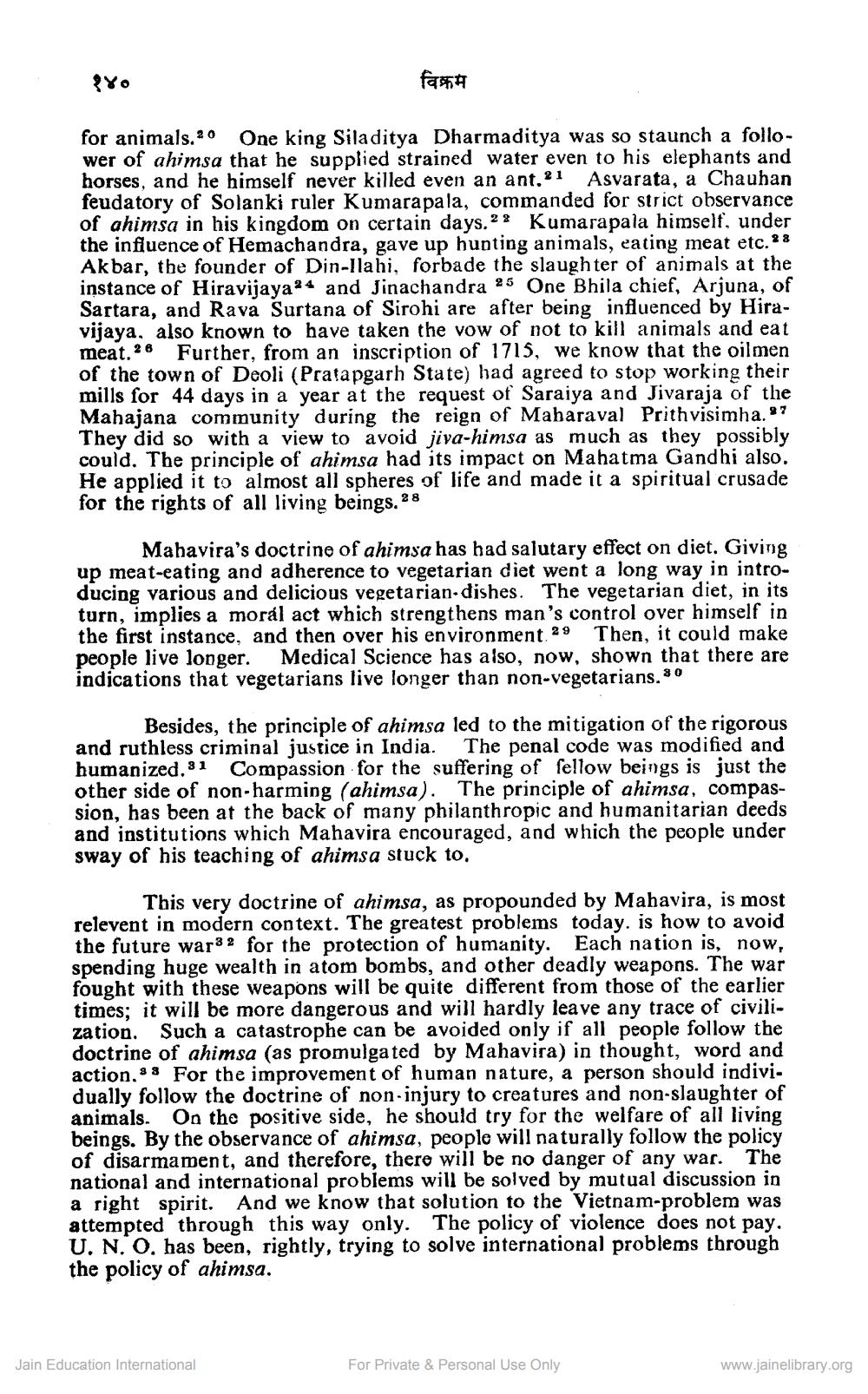________________
380
विक्रम
for animals. 20 One king Siladitya Dharmaditya was so staunch a follower of ahimsa that he supplied strained water even to his elephants and horses, and he himself never killed even an ant. 21 Asvarata, a Chauhan feudatory of Solanki ruler Kumarapala, commanded for strict observance of ahimsa in his kingdom on certain days.22 Kumarapala himself, under the influence of Hemachandra, gave up hunting animals, eating meat etc. * Akbar, the founder of Din-Ilahi, forbade the slaughter of animals at the instance of Hiravijaya 24 and Jinachandra 25 One Bhila chief, Arjuna, of Sartara, and Rava Surtana of Sirohi are after being influenced by Hiravijaya, also known to have taken the vow of not to kill animals and eat meat. 26 Further, from an inscription of 1715, we know that the oilmen of the town of Deoli (Pratapgarh State) had agreed to stop working their mills for 44 days in a year at the request of Saraiya and Jivaraja of the Mahajana community during the reign of Maharaval Prithvisimha. 27 They did so with a view to avoid jiva-himsa as much as they possibly could. The principle of ahimsa had its impact on Mahatma Gandhi also. He applied it to almost all spheres of life and made it a spiritual crusade for the rights of all living beings. 28
Mahavira's doctrine of ahimsa has had salutary effect on diet. Giving up meat-eating and adherence to vegetarian diet went a long way in introducing various and delicious vegetarian-dishes. The vegetarian diet, in its turn, implies a moral act which strengthens man's control over himself in the first instance, and then over his environment 29 Then, it could make people live longer. Medical Science has also, now, shown that there are indications that vegetarians live longer than non-vegetarians. 30
Besides, the principle of ahimsa led to the mitigation of the rigorous and ruthless criminal justice in India. The penal code was modified and humanized. 31 Compassion for the suffering of sellow beings is just the other side of non-harming (ahimsa). The principle of ahimsa, compassion, has been at the back of many philanthropic and humanitarian deeds and institutions which Mahavira encouraged, and which the people under sway of his teaching of ahimsa stuck to,
This very doctrine of ahimsa, as propounded by Mahavira, is most relevent in modern context. The greatest problems today. is how to avoid the future war3 2 for the protection of humanity. Each nation is, now, spending huge wealth in atom bombs, and other deadly weapons. The war fought with these weapons will be quite different from those of the earlier times; it will be more dangerous and will hardly leave any trace of civilization. Such a catastrophe can be avoided only if all people follow the doctrine of ahimsa (as promulgated by Mahavira) in thought, word and action, a 8 For the improvement of human nature, a person should indivi. dually follow the doctrine of non-injury to creatures and non-slaughter of animals. On the positive side, he should try for the welfare of all living beings. By the observance of ahimsa, people will naturally follow the policy of disarmament, and therefore, there will be no danger of any war. The national and international problems will be solved by mutual discussion in a right spirit. And we know that solution to the Vietnam-problem was attempted through this way only. The policy of violence does not pay. U. N. O, has been, rightly, trying to solve international problems through the policy of ahimsa.
Jain Education International
For Private & Personal Use Only
www.jainelibrary.org




